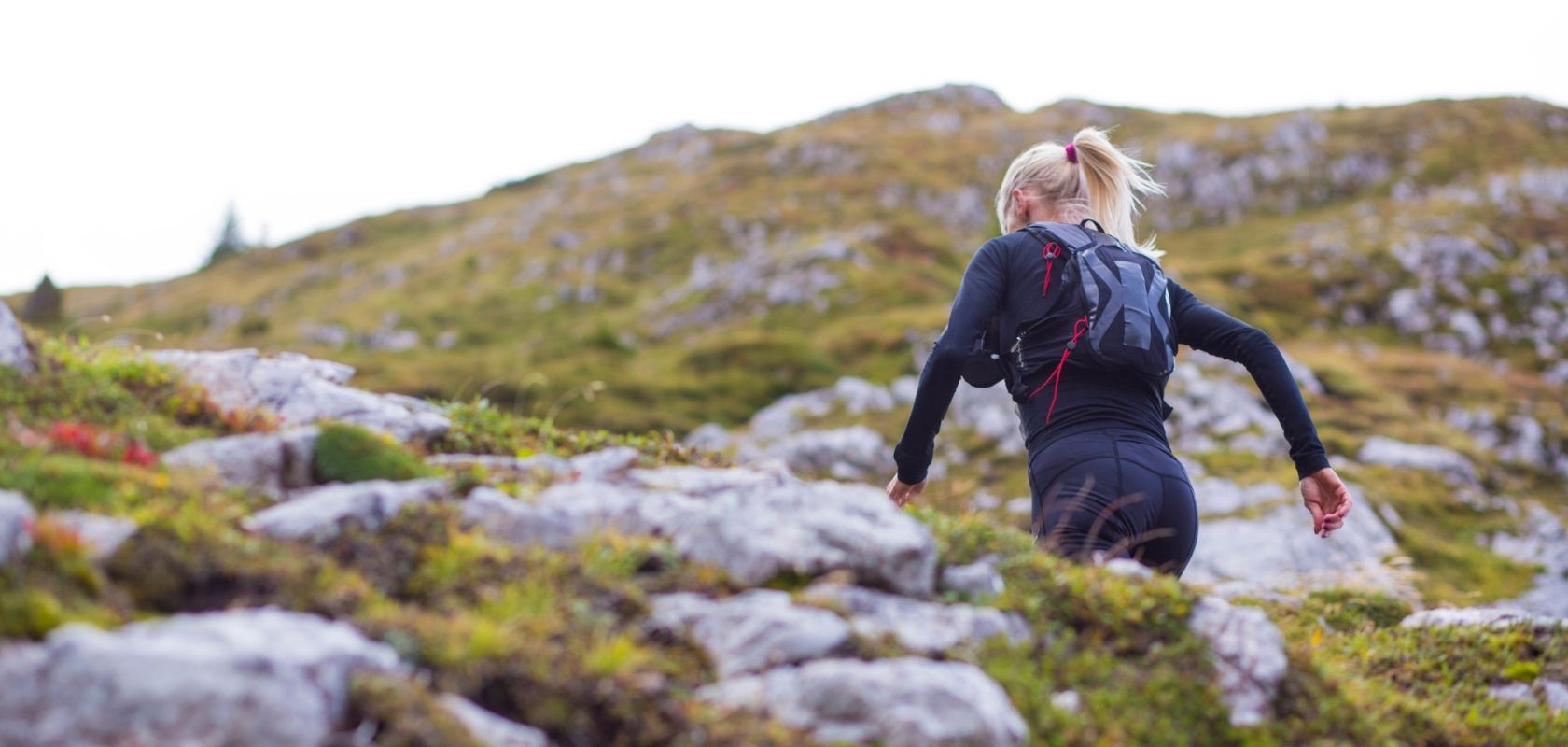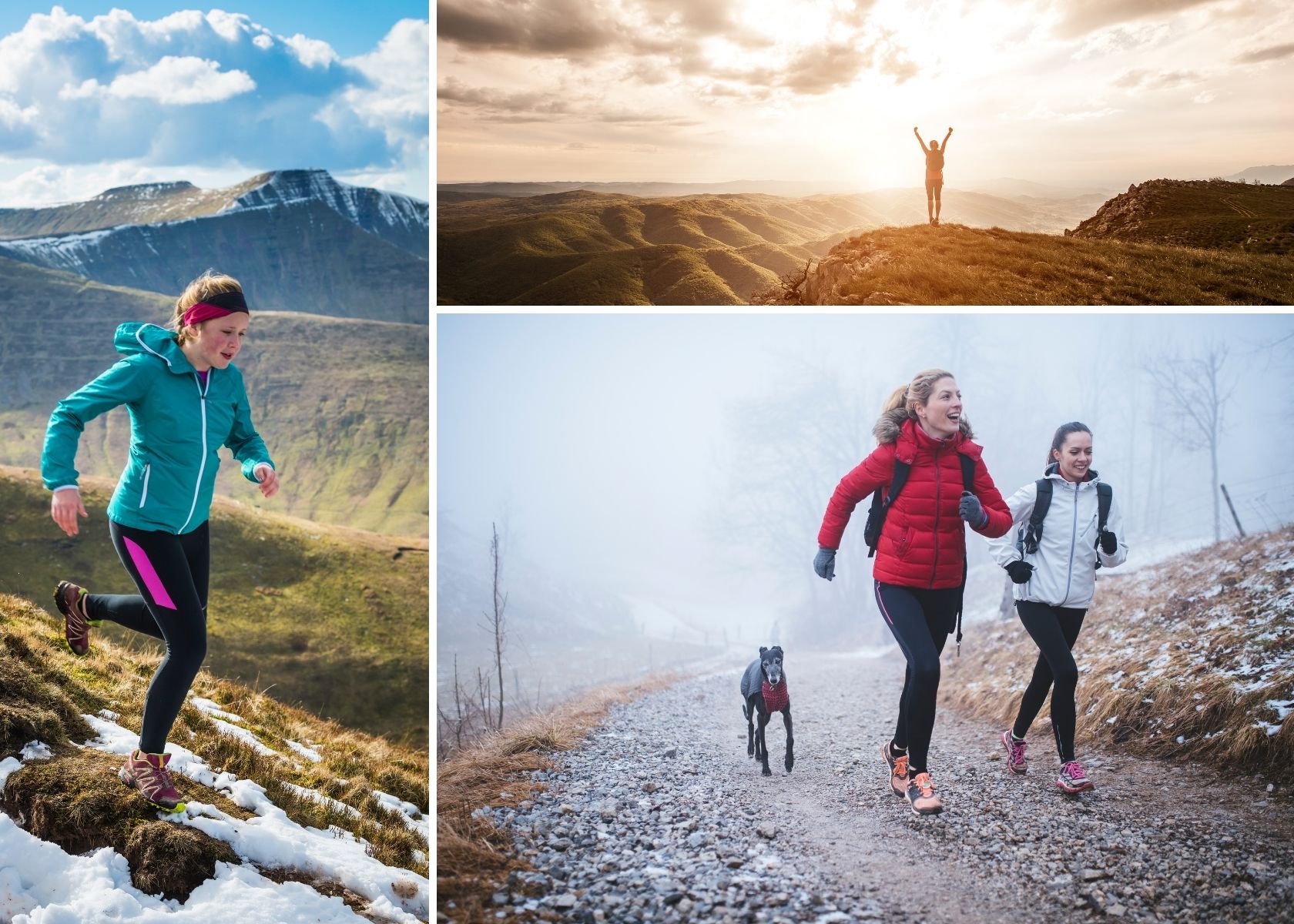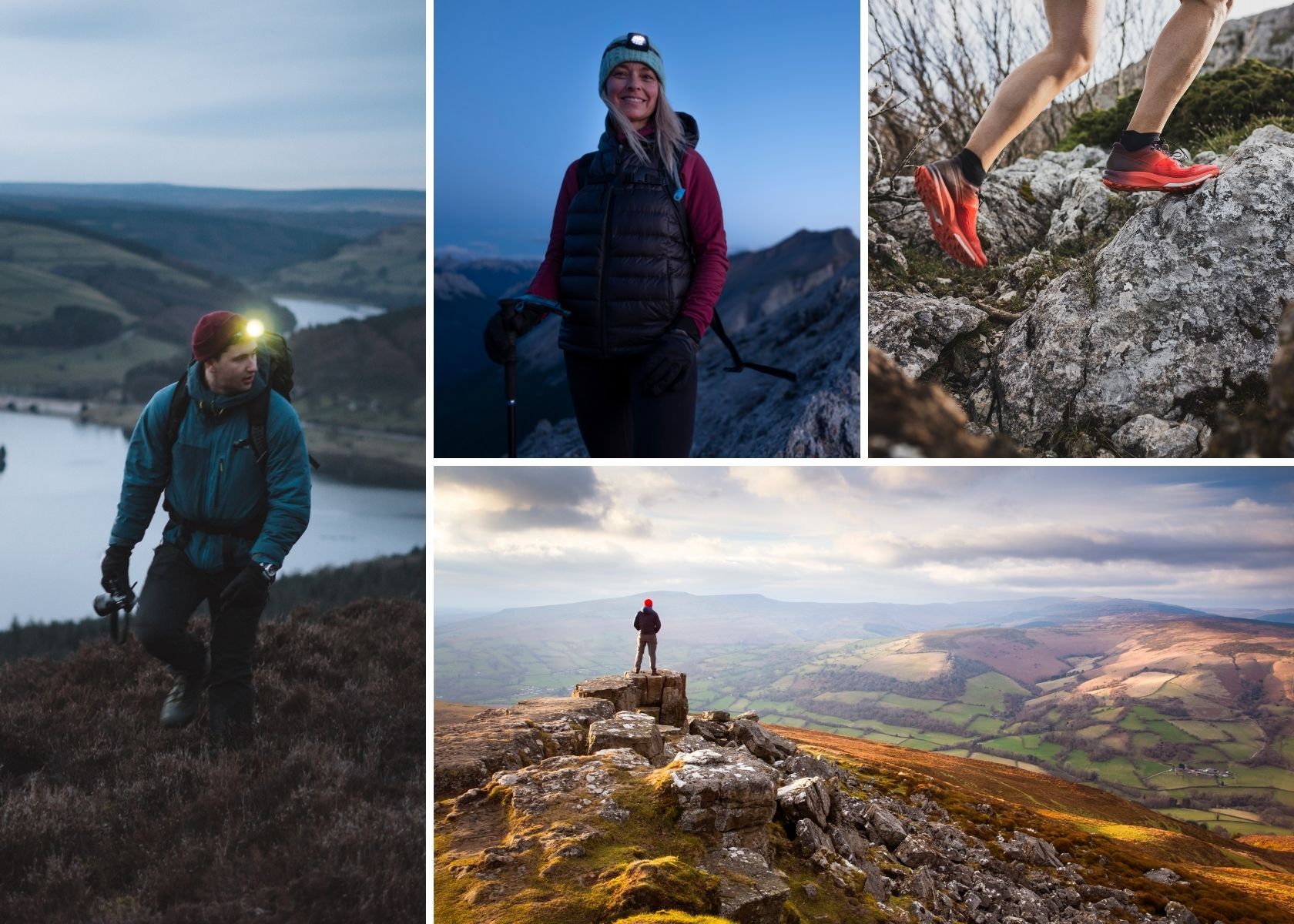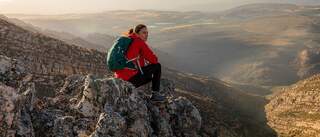TOP 10 FAST AND LIGHT HIKING ESSENTIALS
Fast and light hiking is all about strength: getting fitter, carrying less and moving faster. It's taking only what you need and going as far, as quickly, as possible. Here's all the gear you'll need to pick up the pace through the wilderness.
Footwear
Choosing the right footwear is the foundation of any fast and light hiking kit. The right pair can make all the difference in comfort, performance, and injury prevention on the trail. Your decision will usually come down to two main options: hiking shoes or hiking boots, each with their own strengths and trade-offs.
Hiking Shoes
Hiking shoes are designed for those who prioritise speed, agility, and a lighter pack weight. They are generally lighter than boots, offering excellent shock absorption and flexibility. This makes them ideal for hikers who are reasonably fit and experienced in tackling rough terrain, as the shoes allow for unrestricted movement and quicker pace. However, it’s important to note that hiking shoes lack the ankle support, stability, and protection provided by boots. If you’re confident in your footing and want to move fast, hiking shoes are a strong choice.
Hiking Boots
For those who value support and protection, hiking boots are the go-to option. Boots are heavier but come with built-in ankle protection and increased stability, which can be especially reassuring on uneven or rocky ground. They’re a great pick for anyone who prefers more support or is carrying a heavier pack. The most crucial factor when choosing boots is the fit—ill-fitting boots can quickly turn a hike into a painful ordeal. For the best experience, it’s recommended to visit a specialist store for a free fitting with an expert.
Key points to consider:
- Hiking shoes:
- Lightweight and flexible
- Better shock absorption
- Less ankle support and protection
- Best for fit, experienced hikers seeking speed and freedom
- Hiking boots:
- Heavier, with ankle protection
- Increased stability and support
- Ideal for rough terrain or heavier loads
- Fit is critical—get professionally fitted if possible
Whether you choose shoes or boots, prioritise comfort and fit above all else to ensure your hiking adventures are safe, fast, and enjoyable.
Walking Poles
Walking poles are often underestimated, but they’re a game-changer for anyone aiming to hike fast, light, and efficiently. Far from slowing you down, poles can actually help you maintain a brisk pace and rhythm, especially over long distances and challenging terrain. Their true value often becomes clear on steep descents or after a full day on your feet, when your knees and joints are most vulnerable.
In the short term, walking poles provide extra balance and stability, making it easier to navigate uneven ground, loose rocks, or slippery slopes. They help distribute your load more evenly across your body, reducing fatigue in your legs and preserving energy for longer days on the trail. Over time, this support can make a significant difference: poles reduce the impact on your knees and lower joints, especially during descents, helping to protect your cartilage and stave off long-term injuries.
Additional benefits include:
- Boosts balance and stability on tricky terrain, stream crossings, and steep slopes.
- Reduces strain on knees and joints, particularly on descents and with heavy packs.
- Promotes better posture and breathing by encouraging an upright stance, which can enhance endurance.
- Increases hiking efficiency and rhythm, helping you maintain a steady pace over long distances.
- Distributes effort between upper and lower body, reducing leg fatigue and conserving energy for big days out.
- Versatile tool: can be used for testing water depth, pitching ultralight tents, or even deterring wildlife.
For fast and light hikers, walking poles are not just an accessory—they’re an essential tool for moving efficiently, staying injury-free, and making the most of every mile.
Lightweight Pack
A lightweight pack is central to any fast and light hiking setup. For most day hikes or minimalist overnight trips, a 20–25L pack is all you need—enough to carry essentials without weighing you down. The key is to choose a pack that balances low weight with smart features and, above all, a comfortable fit.
Look for a lightweight, ventilated back panel system to keep air flowing and prevent overheating, especially during high-output hiking. Multiple exterior storage pockets are invaluable for quick access to snacks, water, and layers without needing to stop and unpack. This helps you stay efficient and maintain your momentum on the trail.
The most crucial aspect, however, is the fit of your pack. It should hug your body closely, minimising load movement and ensuring stability as you hike. Proper adjustment of the straps and load lifters is essential to distribute weight evenly, keep you comfortable, and prevent injury—especially over long distances or technical terrain.
Key points to consider:
- Capacity: 20–25L is ideal for fast and light hiking essentials.
- Back panel: Lightweight and ventilated to reduce overheating.
- Storage: Plenty of exterior pockets for easy, on-the-go access.
- Fit: Body-hugging design minimises movement; adjust straps for optimal comfort and weight distribution.
- Comfort: Proper fit and adjustment are essential to prevent chafing and injury.
- Weight: Choose the lightest pack that still offers the features and durability you need.
A well-chosen lightweight pack lets you move quickly, stay organised, and remain comfortable—making every mile more enjoyable and efficient. If you can get to us, visit our in-store experts for your free pack fitting to make sure you get it right.
Navigation
Navigation is a cornerstone of safe, efficient, and enjoyable fast and light hiking. Even if you’re sticking to well-marked trails, having the right navigation tools—and knowing how to use them—can make all the difference if weather rolls in, paths become unclear, or you’re faced with an unexpected detour.
A map and compass are absolute essentials for any hiker. These traditional tools don’t rely on batteries or signal, and knowing how to use them is crucial in case of emergencies or if technology fails. Take time to learn basic map reading and compass skills before heading out—these could be lifesavers in poor visibility or remote terrain.
For day-to-day navigation, however, GPS devices have become invaluable for fast and light hikers. A good GPS unit allows you to:
- Plot your route in advance, so you can focus on moving efficiently rather than stopping to check directions.
- Pinpoint your exact location within seconds, reducing the risk of getting lost and helping you stay on track.
- Download or enter waypoints, making it easy to follow complex routes or hit specific objectives along the way.
- Access full Ordnance Survey mapping (on many devices), providing detailed, up-to-date information at your fingertips.
Key points to remember:
- Map and compass: Always carry them and know how to use them for backup and emergencies.
- GPS device: Great for speed, accuracy, and convenience on the move.
- Waypoints and mapping: Download routes or waypoints in advance for seamless navigation.
- Battery management: Keep your GPS charged and consider carrying spare batteries or a power bank.
By combining traditional navigation skills with modern technology, you’ll hike faster, safer, and with greater confidence—whatever the trail throws your way.
Head Torch
A head torch is an essential item for any fast and light hiking kit. Whether you’re setting off before dawn, hiking into the evening, or simply moving around camp after sunset, having hands-free illumination is crucial for safety, comfort, and efficiency. Modern head torches are compact, lightweight, and incredibly versatile, making them a must-have for every outdoor adventure.
A good head torch frees up your hands for tasks like cooking, pitching a tent, or navigating tricky trails in the dark. It’s also a vital piece of safety equipment—if you’re caught out after dark, a reliable light source can make all the difference, helping you stay on route and signal for help in an emergency.
When choosing a head torch, consider the following features for maximum versatility:
- Brightness: Measured in lumens, brightness levels vary widely. For general hiking and camp use, 200–300 lumens is usually sufficient. For night navigation or more technical terrain, look for models offering 400 lumens or more.
- Light Colours: Many head torches offer multiple light colours (such as white for general use, red for preserving night vision, and sometimes green or blue for specific tasks). Red light is especially useful around camp or when reading maps at night, as it won’t dazzle or disturb others.
- Beam Modes: Look for a torch with both spot (focused, long-distance) and flood (wide, close-up) beam options. Adjustable brightness and beam patterns allow you to tailor the light to your needs, from hiking to in-camp chores.
- Weight and Comfort: Modern head torches are lightweight (often under 100g) and designed for comfort, with adjustable, moisture-wicking headbands.
- Battery Life: Choose a model with long battery life on lower settings, and consider rechargeable options for sustainability. Some torches offer hybrid power (rechargeable and AAA batteries) for added flexibility.
- Weather Resistance: Ensure your head torch is at least splashproof (IPX4), or preferably waterproof, to handle unpredictable weather.
Key points to remember:
- Always pack a head torch, even on day hikes—unexpected delays can leave you finishing in the dark.
- Check your torch and batteries before every trip; carry spare batteries or a power bank for recharging.
- Consider bringing a lightweight backup torch for emergencies.
A reliable head torch is more than just a convenience—it’s a critical safety tool that keeps you moving confidently, whatever the light conditions or time of day.
Hydration
Staying properly hydrated is a cornerstone of fast and light hiking—regardless of the weather. Even in colder conditions, dehydration can creep up on you, leading to early muscle fatigue, reduced concentration, and poor decision making. Ensuring you drink enough water throughout your hike not only boosts your physical performance but also keeps your mind sharp and your energy levels steady.
Why Hydration Matters
- Dehydration impacts performance: Even mild dehydration can impair your focus, slow reaction times, and increase fatigue.
- Cold weather risk: You may not feel as thirsty in cold conditions, but your body still loses water through breathing and sweat, making it just as important to drink regularly.
- Prevention is key: Sip small amounts often, rather than waiting until you feel thirsty or gulping large amounts at once.
Hydration Reservoirs
Hydration reservoirs (also called bladders) are one of the most convenient solutions for staying hydrated on the move. Most modern hiking packs are designed to be hydration-compatible, featuring a dedicated sleeve for the reservoir and a port for the drinking tube to route over your shoulder.
Benefits:
- Hands-free hydration: The drinking tube allows you to sip water without stopping or removing your pack, encouraging frequent, small sips.
- Efficient for movement: Ideal for fast hiking, running, or technical terrain where you want to keep moving.
- Variable sizes: Reservoirs typically hold between 1.5L and 3L—choose based on hike length and water availability.
Considerations:
- Monitor water levels: It can be hard to see how much water you have left without unpacking your bag.
- Cleaning: Bladders require regular cleaning to prevent mold and odors.
- Potential leaks: Make sure to check for leaks before each trip.
Water Bottles
If you prefer simplicity or want a backup, water bottles remain a classic and reliable option. Many hikers carry at least one 1L bottle, ideally in a spot that’s easy to grab—like a hip belt pouch or side pocket.
Benefits:
- Easy to monitor: You can see exactly how much water you have left at a glance.
- Simple to refill and clean: Bottles are straightforward to clean and refill, even at streams or taps.
- Durability: Hard-sided bottles are tough and can withstand rough handling, while soft bottles are ultralight and packable.
- No freezing tubes: Bottles don’t have hoses that can freeze in cold weather.
Considerations:
- Less convenient access: You may need to stop or remove your pack to drink, which can mean you drink less frequently.
- Capacity: Most bottles hold 0.5–1L, so you may need to carry multiple for longer hikes.
Key Hydration Tips
- Aim for half a liter per hour of moderate hiking; increase intake in hot or strenuous conditions.
- Drink before you’re thirsty—set reminders to sip regularly.
- Balance water with electrolytes on longer or hotter hikes to avoid cramps and fatigue.
- Plan your water stops and know where you can refill along your route.
Staying hydrated is about more than just comfort—it’s essential for safety, performance, and enjoyment on every hike. Choose the system that fits your style, and make hydration a habit every time you hit the trail.
Softshell/Windproof Jacket
A softshell or windproof jacket is a cornerstone of any fast and light hiking kit, offering maximum versatility with minimal weight. When you’re aiming to keep your pack as light as possible, you need a layer that can handle a range of conditions without constant changes. Softshells and windproofs are designed to do just that, acting as a reliable windbreaker while providing a touch of insulation and some water resistance for unpredictable weather.
These jackets excel in active conditions where breathability and mobility are key. They’re perfect for blustery ridgelines, cool mornings, or quick stops, and can be worn over a base layer or light midlayer. In really foul weather, a softshell or windproof jacket layers easily underneath a waterproof shell, enhancing warmth and weather protection without bulk.
Key features and benefits:
- Wind protection: Shields you from cold gusts and wind chill, keeping your core temperature stable.
- Light insulation: Offers moderate warmth for active movement without overheating.
- Water resistance: Repels light rain and drizzle, buying you time before you need to reach for a full waterproof.
- Layering versatility: Slim fit allows easy layering under a waterproof jacket in harsh conditions.
- Breathability: Lets sweat escape, reducing clamminess during high-output activity.
- Lightweight and packable: Easy to stash in your pack when not needed, adding minimal weight.
When to use:
- On windy days or exposed terrain
- As your main outer layer in mild, dry weather
- Under a waterproof shell in heavy rain or cold
A good softshell or windproof jacket is an all-in-one solution for fast and light hikers, delivering essential protection and comfort without weighing you down.
Waterproof Jacket
A waterproof jacket is a non-negotiable in any fast and light hiking kit, providing essential protection from rain, wind, and unpredictable weather. When every gram counts, ultralight construction is key—you want a jacket that won’t weigh you down, whether you’re wearing it or carrying it in your pack.
Modern waterproof jackets come packed with technical features, but there’s always a trade-off between weight and technology. More advanced features—like extra pockets, reinforced panels, or enhanced breathability—often add weight. On the other hand, the lightest jackets strip things back to the basics, focusing on minimalism and packability.
To choose the best waterproof jacket for your needs, consider what matters most to you: Is it maximum breathability, durability for rough terrain, or the lowest possible weight? Your priorities will guide your decision.
Key considerations and features:
- Ultralight design: Look for jackets that are as light as possible without compromising on core waterproof performance.
- Packability: A good jacket should compress down small, so it’s easy to stash in your pack until you need it.
- Waterproof technology: Check for reputable membranes (like Gore-Tex, Pertex Shield, or similar) for reliable protection.
- Breathability: Essential for active hiking—look for ventilation features like pit zips or breathable fabrics.
- Minimalist features: Fewer pockets, lighter zips, and simplified hoods all help reduce weight.
- Durability: The lightest jackets may sacrifice some abrasion resistance; consider your terrain and usage.
When to use:
- Any time rain is possible or forecast
- As an emergency layer in the mountains or exposed terrain
- For wind protection in addition to rain
Tips for fast and light hikers:
- Weigh your priorities: do you need more features, or is every gram crucial?
- Try on jackets for fit and comfort—movement is key when hiking fast.
- Always pack your waterproof, even if the forecast looks clear.
Choosing the right waterproof jacket is about balancing weight, protection, and features—so you stay dry, comfortable, and ready for anything the trail throws at you.
Discover how to choose the perfect jacket in our waterproof buying guide.
Nutrition
Nutrition is a critical part of any fast and light hiking adventure, fueling your body for long days and steep climbs. The right food choices help you maintain energy, avoid fatigue, and recover faster, all while keeping your pack weight to a minimum. For fast-moving hikes, focus on calorie-dense, easy-to-digest, and lightweight options that deliver a quick boost when you need it most.
Gels and Bars
Energy gels and bars are staples for fast and light hikers. They’re compact, high in calories, and provide a rapid energy boost when you start to feel your pace dropping. Test a few different brands and flavours before your trip to see what works best for your stomach and taste buds. Many hikers also supplement with nuts, dried fruit, and jerky for variety and sustained energy.
Electrolyte Drinks
Adding an electrolyte mix to your hydration system is a smart move, especially on hot days or during strenuous efforts. Electrolytes help replenish vital salts lost in sweat, preventing cramps and speeding up water absorption. This is crucial for maintaining performance and avoiding fatigue. Some mixes also include carbohydrates for an extra energy kick when you’re flagging.
Key nutrition tips for fast and light hiking:
- Pack calorie-dense foods: Look for snacks and meals that provide at least 100–125 calories per ounce to maximise energy without extra weight.
- Balance your intake: Combine carbohydrates (for quick energy), protein (for muscle recovery), and healthy fats (for long-lasting fuel).
- Snack often: Eat small amounts regularly to maintain steady energy levels and avoid big crashes.
- Try before you hike: Test gels, bars, and electrolyte mixes during training hikes to ensure they agree with you.
- Hydrate with electrolytes: Use electrolyte drinks, especially in hot weather or on long, sweaty days, to maintain your body’s salt balance.
Quick Nutrition Checklist:
- Energy gels and bars for fast fuel
- Nuts, seeds, and dried fruit for sustained energy
- Jerky or hard cheese for protein
- Electrolyte drink mix for hydration and salt balance
- Calorie-dense snacks to keep your pack light and your energy high
Smart nutrition planning means you’ll have the energy to enjoy every mile—without carrying more weight than you need.
First Aid Kit
A first aid kit is a non-negotiable essential for any fast and light hiking trip. The thrill of exploring the unknown comes with the responsibility to be prepared for mishaps—ranging from blisters and cuts to more serious injuries or unexpected nights out. A well-stocked kit, combined with a few extra safety items, can make all the difference in an emergency.
Your kit should be compact but comprehensive, tailored to your trip length, group size, and personal needs. In addition to first aid basics, always carry a survival whistle, a thermal (emergency) bag, and a means of communication (like a fully charged phone and backup power bank). Packing a lightweight neck warmer, fleece gloves, and a hat is also wise, as temperatures can drop quickly or you may need to spend an unplanned night outdoors.
First Aid Kit Essentials:
- Adhesive bandages (various sizes) and blister plasters
- Compression or elastic bandage
- Gauze pads, non-stick pads, and medical tape
- Antibacterial ointment and antiseptic wipes
- Pain relief (ibuprofen, paracetamol)
- Antihistamines (for allergic reactions)
- Antidiarrheal pills
- Tweezers and safety pins
- Small scissors or a knife
- Moleskin or sports tape for blisters
- Latex or nitrile gloves
- Hand sanitiser
- Water treatment tablets
- SPF lip balm and sunscreen
- Bug repellent
Emergency & Comfort Additions:
- Survival whistle (for signalling)
- Thermal (emergency) bag or bivvy
- Fully charged phone and backup power bank
- Neck warmer, light fleece gloves, and a hat (for warmth if stranded)
- First aid manual or card (for quick reference)
Key tips:
- Customise your kit for personal medications and known allergies.
- Check and replenish your kit before every trip.
- Learn basic first aid skills—knowing how to use your kit is just as important as carrying it.
- Keep everything in a waterproof pouch to protect it from the elements.
Carrying a thoughtfully packed first aid kit, along with a few extra emergency items, means you’re ready for whatever the trail throws your way—giving you peace of mind to fully enjoy the adventure.
Related Articles

Let us know you agree to cookies
We use marketing, analytical and functional cookies as well as similar technologies to give you the best experience. Third parties, including social media platforms, often place tracking cookies on our site to show you personalised adverts outside of our website.
We store your cookie preferences for two years and you can edit your preferences via ‘manage cookies’ or through the cookie policy at the bottom of every page. For more information, please see our cookie policy.






